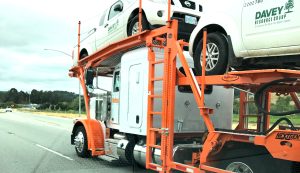Understanding The Basics Of Vehicle Shipping To Honolulu
Shipping a vehicle to Honolulu involves a unique set of considerations compared to mainland transportation. Understanding the basics can help streamline the process and ensure you secure the best rates. First, it’s essential to recognize that shipping a car to Honolulu typically involves both land and sea transport. Vehicles are often transported by truck or rail from their origin point to a port on the West Coast, such as Los Angeles, San Diego, or Seattle.
From there, they are loaded onto specialized vessels for the journey across the Pacific.
The cost of shipping is influenced by several factors. The type of vehicle being shipped plays a significant role; larger vehicles like trucks or SUVs generally incur higher fees due to their size and weight. Additionally, the distance from your starting point to the departure port can affect land transport costs.
Timing is another crucial element. Shipping rates may vary depending on demand and seasonal fluctuations. Booking well in advance can sometimes secure better rates, while last-minute arrangements might be more expensive due to limited availability.
Insurance is also an important aspect of vehicle shipping. Most reputable carriers offer basic coverage included in their pricing; however, reviewing this coverage and considering additional insurance for peace of mind is wise.
Lastly, understanding port regulations in Honolulu is critical for smooth delivery. Each island has specific guidelines regarding vehicle pickup and registration that must be adhered to upon arrival.
By familiarizing yourself with these fundamental aspects of vehicle shipping to Honolulu —transport logistics, cost factors, timing strategies, insurance options, and local regulations—you can navigate the process more effectively and find competitive rates tailored to your needs.
Comparing Different Shipping Methods And Their Costs
When planning to ship a vehicle to Honolulu , understanding the different shipping methods and their associated costs is crucial for making an informed decision. The two primary methods for transporting a vehicle to the islands are Roll-on/Roll-off (RoRo) shipping and container shipping, each with distinct advantages and price points.
Roll-on/Roll-off (RoRo) shipping is often the more economical choice. In this method, vehicles are driven onto a specialized ship designed to carry wheeled cargo. This process simplifies loading and unloading, which can help keep costs lower. RoRo shipping typically ranges from $1,000 to $1,500 depending on the port of origin, type of vehicle, and current market conditions. While cost-effective, RoRo shipping does have some limitations; it generally requires that your vehicle be in running condition and free of personal belongings.
On the other hand, container shipping offers greater flexibility but comes at a higher price point. Vehicles are loaded into containers either individually or with other goods. This method provides additional protection from the elements and potential damage during transit. Container shipping can range from $2,000 to $4,000 or more based on factors such as container size (20-foot vs 40-foot), shared or exclusive use of the container, port fees, and additional services like door-to-door delivery.
This option is ideal for high-value vehicles or owners who wish to include personal items within the same shipment.
Ultimately, your choice will depend on your budget constraints and specific needs for security and convenience. By carefully weighing these options against their respective costs—and possibly consulting multiple shipping companies—you can find a solution that offers both peace of mind and value for money when transporting your vehicle to Honolulu .
Researching Reputable Vehicle Shipping Companies
When it comes to finding the best rates for shipping a vehicle to Honolulu , one of the most crucial steps is researching reputable vehicle shipping companies. A trustworthy company not only ensures your vehicle’s safe arrival but also offers competitive pricing and reliable service. Begin by seeking recommendations from friends, family, or colleagues who have previously shipped vehicles. Personal experiences can provide valuable insights into a company’s reliability and customer service.
Next, delve into online reviews and ratings on platforms such as Google, Yelp, and the Better Business Bureau (BBB). These resources offer a wealth of information regarding customer satisfaction, complaint resolution, and overall performance. Pay attention to recurring themes in reviews; consistent praise or criticism can be indicative of a company’s strengths or weaknesses.
Consider reaching out to multiple companies for quotes. This allows you to compare prices while also gauging their responsiveness and professionalism. Be wary of quotes that are significantly lower than others; while cost-effectiveness is important, extremely low rates may signal subpar service or hidden fees.
It’s also essential to verify that any company you consider is properly licensed and insured. The Federal Motor Carrier Safety Administration (FMCSA) maintains records of licensed carriers and their insurance status. Ensuring your chosen company meets these requirements protects you from potential liabilities.
Finally, inquire about each company’s experience with shipping vehicles specifically to Honolulu . The process involves unique logistical challenges due to the island’s remote location. A company with extensive experience in this area will be better equipped to handle any potential issues that may arise during transit.
By thoroughly researching reputable vehicle shipping companies through personal recommendations, online reviews, proper licensing verification, quote comparisons, and specific experience with Honolulu shipments, you can confidently select a provider that offers both reliability and competitive rates for transporting your vehicle safely across the Pacific.
Factors That Affect The Cost Of Shipping A Vehicle To Honolulu
Shipping a vehicle to Honolulu can be a substantial investment, and understanding the factors that influence the cost is crucial for making an informed decision. Several dynamic elements play into the final price you will pay for transporting your car across the Pacific Ocean. Firstly, the distance from your current location to the departure port significantly impacts costs. The further you are from a major port like those in Los Angeles or San Francisco, the higher your initial ground transportation expenses will be.
Once at the port, ocean freight charges come into play, with prices varying depending on whether you’re shipping to Honolulu or one of Honolulu ’s more remote islands. The size and weight of your vehicle are also critical considerations. Larger vehicles such as trucks and SUVs take up more space and weigh more, thereby increasing shipping costs compared to smaller cars. Additionally, if your vehicle is not in running condition, special handling equipment may be required for loading and unloading, adding to overall expenses.
Seasonal fluctuations can also affect shipping rates. During peak moving seasons—typically summer months—demand surges lead to higher prices due to limited availability of shipping slots. Conversely, off-peak times might offer lower rates but could come with longer wait times for available shipments. Furthermore, different types of transport services offer varying levels of convenience and cost-efficiency. Roll-on/roll-off services (RoRo) are generally cheaper but might expose your vehicle to weather conditions during transit.
Enclosed container shipping offers added protection at a premium price. Lastly, additional services such as door-to-door delivery versus terminal-to-terminal service can significantly impact costs based on convenience and personal preferences.
How To Get Accurate Quotes From Multiple Shippers
To ensure you get the most accurate quotes from multiple vehicle shippers for transporting your car to Honolulu , a methodical approach is essential. Start by conducting thorough research on potential shipping companies. Look for those with specialized experience in handling shipments to Honolulu , as familiarity with the unique logistical challenges of island transport can impact both cost and service quality.
Once you have a shortlist of reputable companies, gather detailed information about your specific shipping requirements. This includes the make and model of your vehicle, its dimensions, weight, desired shipping dates, and preferred delivery location in Honolulu . Providing precise details allows shippers to give you more accurate estimates tailored to your needs.
When contacting these companies for quotes, ask about their pricing structure and what factors influence their rates. Some shippers may offer door-to-door service while others might require drop-off at a port; understanding these differences will help you compare quotes on an apples-to-apples basis. Additionally, inquire about any hidden fees or surcharges that could inflate the initial quote.
To further refine your comparisons, request references or read online reviews from past customers who have shipped vehicles to Honolulu . Their experiences can provide valuable insights into each company’s reliability and customer service quality.
Communication is key throughout this process. Provide all necessary information upfront and respond promptly to any follow-up questions from shippers. This proactive approach not only speeds up the quoting process but also demonstrates your seriousness as a potential customer.
By meticulously gathering and comparing detailed quotes from multiple shippers while considering both costs and service quality, you’ll be well-positioned to find the best rate for shipping your vehicle to Honolulu without compromising on reliability or peace of mind.
Evaluating Additional Services And Hidden Fees
When comparing rates for shipping a vehicle to Honolulu , it is crucial to look beyond the base price and evaluate additional services and potential hidden fees. Many shipping companies offer a range of supplementary services that can add convenience but also increase costs. Understanding these extras will help you make an informed decision.
One common additional service is door-to-door delivery. While this option provides the convenience of having your vehicle picked up from your home and delivered directly to your destination in Honolulu , it often comes at a premium. Alternatively, port-to-port shipping, where you drop off and pick up your vehicle at designated ports, can be more cost-effective but requires more effort on your part.
Insurance coverage is another vital consideration. Basic insurance might be included in the quoted rate, but it may not cover all potential damages during transit. Ensure you understand what is covered and consider purchasing additional insurance for peace of mind if the basic coverage seems insufficient.
It’s also essential to scrutinize the fine print for hidden fees that could inflate your total cost unexpectedly. These may include fuel surcharges, terminal handling fees, or charges for oversized vehicles. Some companies might also levy fees for last-minute changes or cancellations.
Moreover, consider the timeline guarantees offered by different carriers. Expedited shipping options ensure faster delivery but usually come with higher costs compared to standard shipping times.
By carefully evaluating these additional services and being vigilant about hidden fees, you can better assess the true cost of shipping your vehicle to Honolulu and avoid unpleasant surprises later on. This comprehensive approach will ultimately help you find the best rates tailored to your specific needs while ensuring a smooth transportation experience.
Tips For Saving Money On Vehicle Shipping To Honolulu
When looking to save money on shipping a vehicle to Honolulu , strategic planning and informed decision-making can make a significant difference. Start by gathering multiple quotes from different shipping companies. While it might be tempting to go with the first reasonable rate you find, obtaining several estimates allows you to compare options and identify the best deal. Be sure to evaluate what each quote includes—some might appear cheaper but could lack essential services like insurance or door-to-door delivery.
Flexibility with your shipping dates can also lead to cost savings. Shipping during peak seasons typically costs more due to higher demand. If your schedule permits, aim for off-peak times when rates are generally lower. Additionally, booking well in advance can sometimes secure better prices as last-minute reservations often come with premium charges.
Consider the type of service that fits your needs and budget. For instance, port-to-port shipping is usually less expensive than door-to-door service because it involves fewer logistical complexities for the carrier. However, if you live far from a major port on either end of the journey, weigh the cost of transporting your vehicle to and from these ports against any savings.
Another way to reduce expenses is by opting for open transport instead of enclosed transport if weather conditions and vehicle type permit. Open transport is widely used and typically cheaper because it accommodates multiple vehicles at once.
Lastly, ensure your vehicle is in good working condition before shipping; non-operational vehicles often incur additional fees due to the extra effort required in loading and unloading them. By taking these steps—comparing quotes, being flexible with dates, choosing appropriate services, considering transport types, and ensuring operational status—you can significantly cut down on vehicle shipping costs while still ensuring safe delivery to Honolulu .



